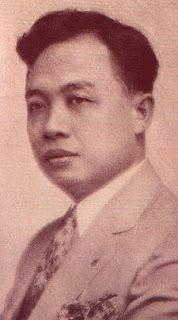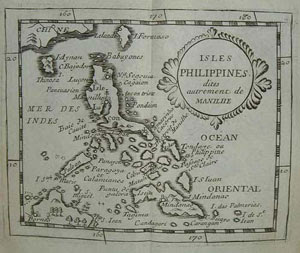1907
- Gen. Macario Sakay, one of the Filipino military leaders who had
continued fighting the imperialist United States invaders eight years
into the Philippine-American War (1899-1914),
is meted out the death sentence; essentially based on the ideals and
principles of the underground-society-turned-revolutionary-government Kataastaasang, Kagalanggalangang Katipunan nang manga Anak nang Bayan (KKK) during the Philippine Revolution against Spain, Sakay had established the Republika ng Katagalugan (entire
Philippines) with a popularly backed guerrilla operations in Morong,
Laguna, Cavite and Quezon in patriotic defiance of the colonial American
government, was deceived by colonial Gov.-Gen. Henry Clay Ide who made it appear that Sakay's
his surrender was necessary to give way to the election of an
all-Filipino Philippine Assembly legislature, falsely promising him and
his supporters amnesty; upon his deceptive abduction by the imperialist Bald Eagle authorities, Sakay could only exclaim to Dominador Gomez, the Filipino collaborator who helped in his trickery: "“Tell the Americans to face us in the open field, in honorable battle.”
1898 - Generals Artemio Ricarte and Pio del Pilar express their misgivings to President Emilio Aguinaldo y Famy as to the real nature of American policy
towards the Philippines; this as Aguinaldo issues a proclamation to the
United States and all foreign governments explaining the nature and
scope of the Revolutionary Government and the proclamation of country's
independence by provincial representatives, begging for the protection
of all nations of the civilized world and beseeching their formal
recognition of the state of belligerence and the independence of the
Philippines;” by February 4 the following year, the imperialist-in-the-making Bald Eagle nation will instigate the bloody and protracted Filipino-American War (1899-1914)
and will eventually successfully invade and occupy the Southeast Asian
nation until 1946 when it will "grant" the Philippines independence (but
not before ensuring its neocolonial status through through agreements and treaties aimed at manipulating and controlling Filipinos' political and economic lives.
Monday, August 6, 2012
Sunday, August 5, 2012
5 AUGUST
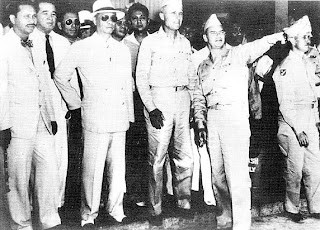 |
| President Manuel Roxas, who campaigned for Parity Rights, w/ American Clark Air Base Officials |
Saturday, August 4, 2012
4 AUGUST
 |
| Military flag of Spanish Empire from 16th to mid 18th century |
1898 - Some nine days prior to the infamous Mock Battle of Manila that would falsely make it appear that the Americans, instead of the Filipino revolutionaries, defeated the Spanish colonial forces in the Southeast Asian archipelago and the capital, Manila, Consul Oscar F. Williams of the emerging imperialist United States cables American Secretary of State William R. Day to report that he has tried to convince Gen. Emilio Aguinaldo y Famy that American rule over the Philippines will supposedly bring greater honor, progress, and profit to the natives compared to any scheme the Filipino leader and his advisers can ever devise; Williams adds that he is on better terms with Aguinaldo than the United States military commanders are with Aguinaldo, the leader of the second phase of the Philippine Revolution who has stupidly forged an "alliance" with U.S. Admiral George Dewey and believed his and other American military and diplomatic officials' verbal deceptive promises that the Bald Eagle nation will honor Philippine independence; apparently realizing that the imperialist Americans have him duped, Aguinaldo--who weeks earlier even ridiculously instructed his men to allow the G.I.'s to freely enter the archipelago--will then try to 'negotiate' Filipinos' independence; the Mock Battle of Manila will form the prelude to the baseless December 1898 Treaty of Paris where by that time, the virtually expelled Spaniards will supposedly "cede" the Philippines to imperialist America, ultimately leading to the bloody and protracted Filipino-American War (1899-1914).
Friday, August 3, 2012
3 AUGUST
1900 - One and one-half years into the protracted and bloody period of American invasion (Filipino-American War, 1899-1914), the President of the Philippine Republic-on-the-run Emilio Aguinaldo issues a manifesto wherein he appeals to the Filipinos not to listen to native collaborators but, rather, to continue fighting without end in defence of their rights until victory against the imperialist enemy is achieved and independence won and recognized.
 1901 - exactly a year later, following the capture of several officials and their subsequent swearing of fealty to the imperialist Bald Eagle nation, including Aguinaldo, Gen. Ambrosio Mojica, Gen. Vicente Lukban of the Samar-Leyte command issues a proclamation, part of which says:
1901 - exactly a year later, following the capture of several officials and their subsequent swearing of fealty to the imperialist Bald Eagle nation, including Aguinaldo, Gen. Ambrosio Mojica, Gen. Vicente Lukban of the Samar-Leyte command issues a proclamation, part of which says:
1898 - In a speech at Kawit in Cavite province, Emilio F. Aguinaldo, President of the fledgling Philippine Republic, pleads with local officials to keep unity, peace, and upright conduct; the appeal comes amidst apprehensions expressed by Felipe Agoncillo and Apolinario Mabini, Aguinaldo's diplomatic official and key adviser, respectively, over the former's supposed "alliance" with the Americans, with some Filipino soldiers already thinking at that point they they might need to fight a war with the pale-skinned US forces.
Photo credit: http://philippineamericanwar.webs.com/thelastholdouts.htm
 1901 - exactly a year later, following the capture of several officials and their subsequent swearing of fealty to the imperialist Bald Eagle nation, including Aguinaldo, Gen. Ambrosio Mojica, Gen. Vicente Lukban of the Samar-Leyte command issues a proclamation, part of which says:
1901 - exactly a year later, following the capture of several officials and their subsequent swearing of fealty to the imperialist Bald Eagle nation, including Aguinaldo, Gen. Ambrosio Mojica, Gen. Vicente Lukban of the Samar-Leyte command issues a proclamation, part of which says: "Nothing, in truth, is more natural than that we should continue the struggle, whatever be the obstacles placed in our way and despite the capture of him who was our generals;… We should let the world know that the Philippine army is captured, another at once comes forward and succeeds him; that we fight, not at the suggestion of others, but because of our own personal convictions; and that, finally, we are worthy of independence and of universal respect, because we know our rights and how to die in their defense…"
Photo credit: http://philippineamericanwar.webs.com/thelastholdouts.htm
Thursday, August 2, 2012
2 AUGUST
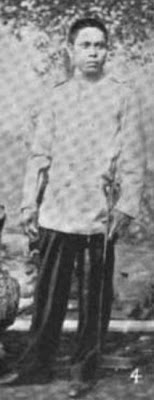 |
| Hen. Isidoro Torres y Dayao |
Wednesday, August 1, 2012
1 AUGUST
 |
| Pangulong Manuel L. Quezon (1878-1944) |
1944 - Manuel Luis Quezon, first President of the Commonwealth of the Philippines under the colonial occupation of the imperialist United States, dies from tuberculosis at Saranac Lake, New York during World War II while the Southeast Asian country was under Japanese Occupation.
Tuesday, July 31, 2012
31 JULY
 |
| Colonial body Philippine Assembly, imperialist US Occupation |
Photo credit: http://philippineamericanwar.webs.com/
Monday, July 30, 2012
30 JULY
1934 - During the imperialist American Period, Claro M. Recto is elected president of the Constitutional Convention
tasked with framing what would be called the 1935 Constitution of
colonial Philippines; Recto, an outspoken Filipino nationalist and critic of the
United States Military Bases, will die in Rome in 1960 due to
a mysterious heart attack suspected to be a work of the Bald Eagle's Central
Intelligence Agency based on an earlier CIA plan to assassinate him with
a vial of poison,
his having no known heart ailment, and the US agency's record of
playing 'holed condom' electoral dirty tricks on the solon during his
presidential bid in the 1957 presidential elections.
1896 - Filipino reformist, patriot and polymath Jose Mercado Rizal receives a letter from Gov.-Gen. Ramon Blanco permitting him to work as physician for the Spanish Army in Cuba,
1601 - Antonio de Morga, Spanish colonial judge for the Philippine Islands during the colonial rule of Spin writes King Philip II about his services in equipping and supplying and leading the naval battle with Dutch corsairs who have been preying on shipping that enter Manila harbor.
1896 - Filipino reformist, patriot and polymath Jose Mercado Rizal receives a letter from Gov.-Gen. Ramon Blanco permitting him to work as physician for the Spanish Army in Cuba,
1601 - Antonio de Morga, Spanish colonial judge for the Philippine Islands during the colonial rule of Spin writes King Philip II about his services in equipping and supplying and leading the naval battle with Dutch corsairs who have been preying on shipping that enter Manila harbor.
Sunday, July 29, 2012
29 JULY
Photo credit: http://www.chrispforr.net/row2/chrisphil7/neocolonial/neocolonial.htm
Saturday, July 28, 2012
28 JULY
 |
| Imperialist American Civil Gov.-Gen William Forbes (right, back row) |
-- 54 years earlier, on July 28, 1855, Juan B. Marcaido is granted a gold medal for his efforts and studies on the method of banana fiber extraction by the Economics Society of Friends of the Country; on July 28, 1963, 24 Philippine Boy Scouts and Scouter delegates to the 11th Boys Scout World Jamboree in Marathon, Greece, perish in a airplane crash in the Arabian Sea.
Photo credit: http://manila.usembassy.gov/wwwjq561.jpg
Friday, July 27, 2012
27 JULY
 1645
- Native Muslims attack the Spanish garrison with help from a Dutch
squadron that arrives at Jolo from Batavia (North Jakarta) during Spain's colonial rule of the Philippines; the Filipino-Spanish troops
under Commander Esteban Ugalde will resist and finally force the withdrawal of the squadron after three days of combat
in what would be one of the few unsuccessful attempts of the
Dutch to expel the Spaniards from the Philippine islands; the contexts are
Spain's tenuous hold on Mindanao and the so-called 80 Years War of Netherlands' revolt and, subsequently, assertion of its independence; Spain's colonization of the Southeast Asian islands began in the mid 1500s when King Philip II sent sent an expedition to conquer said archipelago in 1559 following earlier exploration missions including that led by Ferdinand Magellan who was killed by the native chieftain Lapu-Lapu and his forces in the island of Mactan.
1645
- Native Muslims attack the Spanish garrison with help from a Dutch
squadron that arrives at Jolo from Batavia (North Jakarta) during Spain's colonial rule of the Philippines; the Filipino-Spanish troops
under Commander Esteban Ugalde will resist and finally force the withdrawal of the squadron after three days of combat
in what would be one of the few unsuccessful attempts of the
Dutch to expel the Spaniards from the Philippine islands; the contexts are
Spain's tenuous hold on Mindanao and the so-called 80 Years War of Netherlands' revolt and, subsequently, assertion of its independence; Spain's colonization of the Southeast Asian islands began in the mid 1500s when King Philip II sent sent an expedition to conquer said archipelago in 1559 following earlier exploration missions including that led by Ferdinand Magellan who was killed by the native chieftain Lapu-Lapu and his forces in the island of Mactan.Photo credit: http://www.absoluteastronomy.com/topics/Sulu_Archipelago
Thursday, July 26, 2012
26 JULY
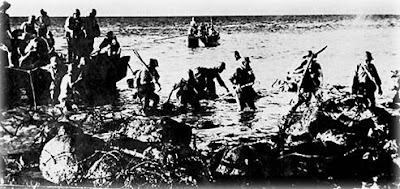 |
| Japanese occupies the US colony, the Philippines |
Photo credit: http://www.smccd.net/accounts/skylib/oralhist/Ignacio/
Wednesday, July 25, 2012
25 JULY
 |
| Hen. Santiago V. Alvarez |
Tuesday, July 24, 2012
24 JULY
 |
| Filipinos captured by American invaders |
Photo credit: Filipiniana.net
Monday, July 23, 2012
23 JULY
 1864 - Apolinario Mabini y Maranan, the future "Brains of the Philippine Revolution", key adviser, and Foreign Minister of what would be the short-lived Philippine Republic under Gen. Emilio Aguinaldo, is born in Talaga, Tanauan, Batangas to Dionisia Maranan and Inocencio Mabini during the Spanish colonial rule; acquiring paralysis later in adulthood, Mabini will be summoned to become an adviser of Aguinaldo who, by that time, had already seized revolutionary leadership from Generalissimo Andres Bonifacio y de Castro during the time of the Philippine Revolution against Spain; Mabini will be one of the few officials of the fledgling Philippine Republic that will for some time resist the pressure of swearing fealty to the imperialist United States of America during the Filipino-American War (1899-1914) ; it will be the second phase of the Philippine Revolution that Mabini will become a key Filipino figure--his counterpart during the initial phase of the Himagsikan led by Bonifacio, co-founder and Supremo of the Kataastaasang Kagalanggalangang Katipunan nang manga Anak nang Bayan, will be Emilio Jacinto y Dizon, who will earn the title "Brains of the Katipunan; a few years before his death, Mabini will author his memoirs of the Philippine Revolution, including his account of Aguinaldo's "insubordination" to, and the tragic "crime" and "assassination" committed against Bonifacio.
1864 - Apolinario Mabini y Maranan, the future "Brains of the Philippine Revolution", key adviser, and Foreign Minister of what would be the short-lived Philippine Republic under Gen. Emilio Aguinaldo, is born in Talaga, Tanauan, Batangas to Dionisia Maranan and Inocencio Mabini during the Spanish colonial rule; acquiring paralysis later in adulthood, Mabini will be summoned to become an adviser of Aguinaldo who, by that time, had already seized revolutionary leadership from Generalissimo Andres Bonifacio y de Castro during the time of the Philippine Revolution against Spain; Mabini will be one of the few officials of the fledgling Philippine Republic that will for some time resist the pressure of swearing fealty to the imperialist United States of America during the Filipino-American War (1899-1914) ; it will be the second phase of the Philippine Revolution that Mabini will become a key Filipino figure--his counterpart during the initial phase of the Himagsikan led by Bonifacio, co-founder and Supremo of the Kataastaasang Kagalanggalangang Katipunan nang manga Anak nang Bayan, will be Emilio Jacinto y Dizon, who will earn the title "Brains of the Katipunan; a few years before his death, Mabini will author his memoirs of the Philippine Revolution, including his account of Aguinaldo's "insubordination" to, and the tragic "crime" and "assassination" committed against Bonifacio. 1567 - Miguel Lopez de Legaspi, the Spanish conquistador who forged a blood compact with the Filipino natives and deceived them into thinking that his people were friends, subsequently facilitating Spain's colonization of the Southeast Asian islands, reports to King Philip II about how Chinese and Japanese come yearly to some islands in the archipelago, such as Luzon and Mindoro, to trade silk, wool bells, iron, tin, porcelains, perfumes, colored cotton cloths and other small wares in exchange for gold and wax.
Raw image credit: National Historical Institute
Sunday, July 22, 2012
22 JULY
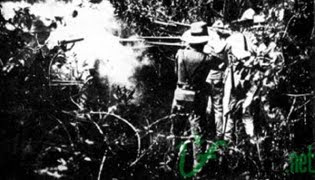 |
| Filipino soldiers resisting imperialist United States invasion |
Saturday, July 21, 2012
21 JULY
1898 - Felipe Agoncillo y Encarnacion, future Minister Plenipotentiary of the fledgling Philippine Republic, writes Apolinario Mabini y Maranan, key adviser of President Emilio Aguinaldo y Famy, expressing his apprehensions over the supposed "alliance" with the Americans
in apparent reference to Aguinaldo's (unofficial and gullible)
"alliance"
arrangement with certain United States officials during the second
phase of the Philippine Revolution; Aguinaldo's deal involved Filipinos'
cooperation in the U.S. war
against Spain and in return, America is supposed to honor the
independence of the Filipino nation; as will later be revealed,
Admiral George Dewey, Consul-General in Singapore E. Spencer Pratt;
Consul General in Hong Kong Rounsevelle Wildman, and Gen. Thomas Anderson have deceived Aguinaldo, what with the the Bald Eagle nation later invading the
Philippines come February 1899 (with the hostilities triggering the bloody and protracted Filipino-American War, 1899-1914), to be secretly instigated by the imperialist US generals upon instructions from their President William McKinley); Mabini will later write in his memoirs
that "Mr.
Aguinaldo had accepted [the verbal promises] because he ardently
desired to return to the islands, fearful that other influential
Filipinos should (rob him of glory and) reach an understanding with the
Americans in the name of the people."
Friday, July 20, 2012
20 JULY
 |
| William Rufus Day, Imperialist Asst. State Secretary |
Thursday, July 19, 2012
19 JULY
 |
| Bust of Gen. Simon de Anda on the wall of Santa Cruz Church |
1770 - General Simon de Anda assumes the position of governor-general of the Spanish colony,t he Philippine Islands, replacing Governor Jose Raón; during his administration, he informs the King of Spain of complaints made against the abuses of the friars and officials against the natives; successfully opposes the King's November 9, 1774 decree secularizing curacies held by the regulars; repairs the walls of Manila; shortly embarks on the building of several war vessels; some eight years earlier, Anda was responsible for organizing a new Spanish base in Bacolor, Pampanga during the period of British occupation of Manila; over 200 years earlier, the Spaniards began to colonize the Southeast Asian archipelago following several expeditions sent by the monarch, including the exploration led by Ferdinand Magellan in the 1520s.
Wednesday, July 18, 2012
18 JULY
Photo credit: http://jibraelangel2blog.blogspot.com/2010/06/members-of-royal-spanish-army-filipino.html
Tuesday, July 17, 2012
17 JULY
Photo credit: http://senorenrique.blogspot.com/2007/06/inside-bahay-tsinoy.html
Monday, July 16, 2012
16 JULY
 1844 - Narciso Claveria y Zaldua becomes governor-general of the Philippines during the Spanish colonial rule; his administration will be responsible for correcting the Philippine calendar; establishing the Sociedad de Recreo (Recreation Association); the founding of papers such as Diario de Manila and La Esperanza; constructing a military library; the purchase of the first steam war-vessel for the Southeast Asian colony; and issuing a decree obligating the natives to adopt Spanish surnames from a catalogue (Catalogo de Apellidos) for the purpose of easier taxation and identification, exempting only pre-Spanish royalty and Chinese with pre-existing surnames; Claveria would also be responsible for granting Jose Oranguyen, Spanish lawyer-turned-businessman-then-(Tondo)judge-and-explorer, the permit to colonize Davao--a 'mini-conquista'--eventually leading to the area being constituted as a province (Nueva Guipizcoa) with Nueva Bergara (future Davao City) as capital; the 62nd Spanish colonial governor in the Philippines would also be responsible for the conquest of the Sulu island of Balanguingui some four years into his term, overcoming the Moros for which he would be accorded the titles viscount of claveria and count of Mnaila along with the cross of San Fernando.
1844 - Narciso Claveria y Zaldua becomes governor-general of the Philippines during the Spanish colonial rule; his administration will be responsible for correcting the Philippine calendar; establishing the Sociedad de Recreo (Recreation Association); the founding of papers such as Diario de Manila and La Esperanza; constructing a military library; the purchase of the first steam war-vessel for the Southeast Asian colony; and issuing a decree obligating the natives to adopt Spanish surnames from a catalogue (Catalogo de Apellidos) for the purpose of easier taxation and identification, exempting only pre-Spanish royalty and Chinese with pre-existing surnames; Claveria would also be responsible for granting Jose Oranguyen, Spanish lawyer-turned-businessman-then-(Tondo)judge-and-explorer, the permit to colonize Davao--a 'mini-conquista'--eventually leading to the area being constituted as a province (Nueva Guipizcoa) with Nueva Bergara (future Davao City) as capital; the 62nd Spanish colonial governor in the Philippines would also be responsible for the conquest of the Sulu island of Balanguingui some four years into his term, overcoming the Moros for which he would be accorded the titles viscount of claveria and count of Mnaila along with the cross of San Fernando.
Sunday, July 15, 2012
15 JULY
 |
| Rey Felipe II de Espana (King Philip II of Spain) |
Photo credit: Wikipedia
Saturday, July 14, 2012
14 JULY
 |
| Maj. Gen. Elwell Otis of the imperialistic U.S. "fighting, having begun, must go on to the grim end" |
Photo art: JB
Raw photo: Wikipedia
Friday, July 13, 2012
13 JULY
 1901 - Gen. Miguel Malvar y Carpio succeeds as Commander-in-Chief of the beleaguered Philippine Republic following President Emilio F. Aguinaldo's treacherous capture by, and hasty swearing of fealty to, the imperialist United States forces nearly 2 1/2 years into the protracted and bloody Filipino-American War (1899-1914); more than three years earlier, Bald Eagle Commodore George Dewey had earlier met with Aguinaldo to strike an alliance, with Filipinos in his nation's separate war with Spain, deceptively making assurances that America is intends to honor Philippine independence; by August 1898, the US and Spain wickedly staged the infamous Mock Battle of Manila that falsely showed to the world that it was the Americans instead of the Filipinos defeated the Spaniards in the capital, Manila; in five months' time, the Treaty of Paris will be signed, with the virtually ousted-by-Filipinos Spain ridiculously 'ceding' the Philippines to the Bald Eagle nation for $20,000,000 US, and on February 4, 1899, American generals will deliberately instigate the bloody and protracted Philippine-American War (1899-1914) in the nefarious bid of the US President William McKinley to make their Congress approve the Treaty of Paris and the annexation [translation: invasion] of the fledgling Southeast Asian nation; Malvar would reverse Aguinaldo's policy of upholding elite interests, giving importance to the role of peasantry in the anti-imperialist resistance and resulting to covert support of the townspeople to the Filipino freedom fighters while pretending to cooperate with the North American colonizers; by December 1901, Malvar would shift from defensive to offensive campaigns against a number of towns held by the enemy Americans; it would only be after US Gen. Franklin Bell's horrific reconcentration campaign that would break the back of the resistance movement in Batangas province that Gen. Malvar will surrender to enemy flag in 1902 ; other Filipino guerrila leaders, such as Macario Sakay and Simeon Ola, and Muslim compatriots in the South will continue the valiant war against the heavily armed North American invaders until about 1913.
1901 - Gen. Miguel Malvar y Carpio succeeds as Commander-in-Chief of the beleaguered Philippine Republic following President Emilio F. Aguinaldo's treacherous capture by, and hasty swearing of fealty to, the imperialist United States forces nearly 2 1/2 years into the protracted and bloody Filipino-American War (1899-1914); more than three years earlier, Bald Eagle Commodore George Dewey had earlier met with Aguinaldo to strike an alliance, with Filipinos in his nation's separate war with Spain, deceptively making assurances that America is intends to honor Philippine independence; by August 1898, the US and Spain wickedly staged the infamous Mock Battle of Manila that falsely showed to the world that it was the Americans instead of the Filipinos defeated the Spaniards in the capital, Manila; in five months' time, the Treaty of Paris will be signed, with the virtually ousted-by-Filipinos Spain ridiculously 'ceding' the Philippines to the Bald Eagle nation for $20,000,000 US, and on February 4, 1899, American generals will deliberately instigate the bloody and protracted Philippine-American War (1899-1914) in the nefarious bid of the US President William McKinley to make their Congress approve the Treaty of Paris and the annexation [translation: invasion] of the fledgling Southeast Asian nation; Malvar would reverse Aguinaldo's policy of upholding elite interests, giving importance to the role of peasantry in the anti-imperialist resistance and resulting to covert support of the townspeople to the Filipino freedom fighters while pretending to cooperate with the North American colonizers; by December 1901, Malvar would shift from defensive to offensive campaigns against a number of towns held by the enemy Americans; it would only be after US Gen. Franklin Bell's horrific reconcentration campaign that would break the back of the resistance movement in Batangas province that Gen. Malvar will surrender to enemy flag in 1902 ; other Filipino guerrila leaders, such as Macario Sakay and Simeon Ola, and Muslim compatriots in the South will continue the valiant war against the heavily armed North American invaders until about 1913. Photo credit: http://fil.wikipilipinas.org/images/0/0d/Miguelmalvar.jpg
Thursday, July 12, 2012
12 JULY
 1899 - Filipino Gen. Artemio Ricarte y Garcia issues a circular asking for contributions to continue war operations against enemy American forces, five months into the imperialistic United States invasion of the fledgling Philippine Republic; the bloody Filipino-American War (1899-1914) broke out in February 1899 after the Republican administration of Bald Eagle President William McKinley deliberately instigated hostilities between the Filipino and American forces at the San Juan bridge as part of his sinister plan to make the US Senate approve the December 1898 Treaty of Paris to pave the way for the annexation [translation: invasion] of the fledgling Southeast Asian Republic; more than a year earlier, the emerging imperialist power that was the US forged an alliance with revolutionary leader Emilio Aguinaldo y Famy as part of its war against colonial Spain during the second phase of the Philippine Revolution, deceptively promising to honor the independence of the Filipinos; weeks later, amidst the fact that the Filipino revolutionary forces have already wrested control of virtually all of the entire archipelago from the Spaniards, the Americans further conned Aguinaldo by asking him to "not to interfere" and allow the free entry of G.I.s into the islands only to stage the infamous Mock Battle of Manila that falsely showed to the world that the Americans--instead of the Filipinos--were the ones who defeated the Spaniards in Manila; Spain and the US would then sign the Paris Treaty that 'ceded' the Philippines as McKinley justifies his undemocratic, treacherous policy before the American public by ridiculously claiming that God had supposedly spoken to him to colonize the Southeast Asian land "to educate the Filipinos, and uplift and Christianize them,"--this, when most of the Philippines have long been Catholic Christians.
1899 - Filipino Gen. Artemio Ricarte y Garcia issues a circular asking for contributions to continue war operations against enemy American forces, five months into the imperialistic United States invasion of the fledgling Philippine Republic; the bloody Filipino-American War (1899-1914) broke out in February 1899 after the Republican administration of Bald Eagle President William McKinley deliberately instigated hostilities between the Filipino and American forces at the San Juan bridge as part of his sinister plan to make the US Senate approve the December 1898 Treaty of Paris to pave the way for the annexation [translation: invasion] of the fledgling Southeast Asian Republic; more than a year earlier, the emerging imperialist power that was the US forged an alliance with revolutionary leader Emilio Aguinaldo y Famy as part of its war against colonial Spain during the second phase of the Philippine Revolution, deceptively promising to honor the independence of the Filipinos; weeks later, amidst the fact that the Filipino revolutionary forces have already wrested control of virtually all of the entire archipelago from the Spaniards, the Americans further conned Aguinaldo by asking him to "not to interfere" and allow the free entry of G.I.s into the islands only to stage the infamous Mock Battle of Manila that falsely showed to the world that the Americans--instead of the Filipinos--were the ones who defeated the Spaniards in Manila; Spain and the US would then sign the Paris Treaty that 'ceded' the Philippines as McKinley justifies his undemocratic, treacherous policy before the American public by ridiculously claiming that God had supposedly spoken to him to colonize the Southeast Asian land "to educate the Filipinos, and uplift and Christianize them,"--this, when most of the Philippines have long been Catholic Christians. Raw photo credits:
http://www.army.mil.ph/About_the_army/army/history/lineage/01.gif
Wikipedia
Wednesday, July 11, 2012
11 JULY
 |
| Dr. Pio Valenzuela |
Tuesday, July 10, 2012
10 JULY
1941 - During the imperialist American Occupation, blackout practices in Manila and other parts of the Philippines are held in anticipation of the Pacific Theatre phase of World War II; apart from the blackouts wherein lights are dimmed so as not to make a certain place conspicuous and easy target for attacks, the colonial United States and Filipino officials also establish evacuation centers and "air-aid drills" in the Southeast Asian archipelago some five months before the Japanese Imperial Army begins invading the US-occupied Philippines following the Asian power's bombing of the Bald Eagle's naval base at Pearl Harbor (December 1941).
Photo credit: anderson militario.com
Photo credit: anderson militario.com
Monday, July 9, 2012
9 JULY
 |
| US Forces, on a sinister hidden plan to invade the Philippines, disembark |
Photo credit: Filipiniana.net
Sunday, July 8, 2012
8 JULY
 |
| Imperialist American soldiers march to Manila |
Photo credit: Filipiniana.net
Subscribe to:
Posts (Atom)

